The AMD Radeon R9 290X Review
by Ryan Smith on October 24, 2013 12:01 AM EST- Posted in
- GPUs
- AMD
- Radeon
- Hawaii
- Radeon 200
Company of Heroes 2
Our second benchmark in our benchmark suite is Relic Games’ Company of Heroes 2, the developer’s World War II Eastern Front themed RTS. For Company of Heroes 2 Relic was kind enough to put together a very strenuous built-in benchmark that was captured from one of the most demanding, snow-bound maps in the game, giving us a great look at CoH2’s performance at its worst. Consequently if a card can do well here then it should have no trouble throughout the rest of the game.
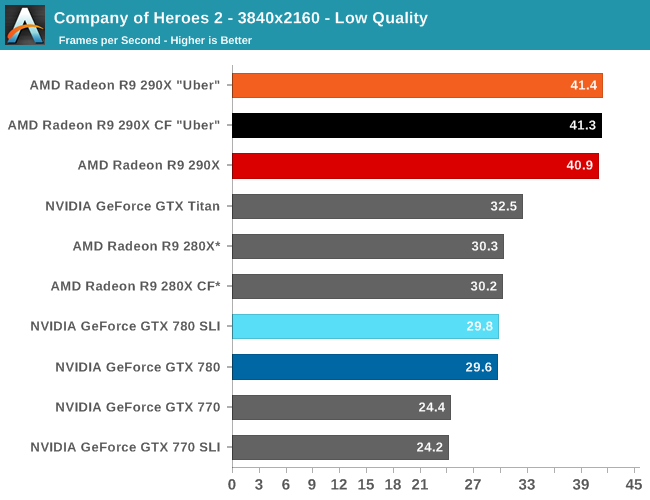
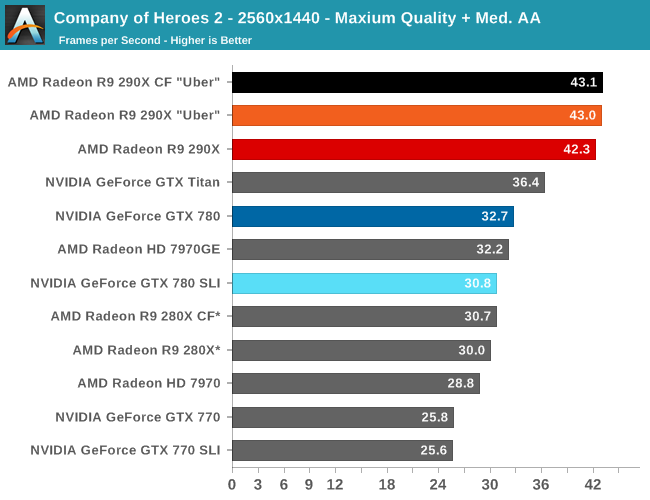
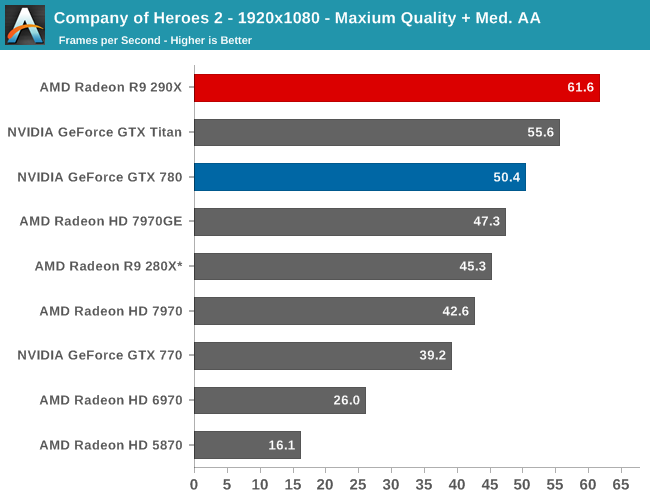
Our first strategy game is also our first game that is flat out AFR incompatible, and as a result the only way to get the best performance out of Company of Heroes 2 is with the fastest single-GPU card available. To that end this is a very clear victory for the 290X, and in fact will be the largest lead for the 290X of all of our benchmarks. At 2560 it’s a full 29% faster than the GTX 780, which all but puts the 290X in a class of its own. This game also shows some of the greatest gains for the 290X over the 280X, with the 290X surpassing its Tahti based predecessor by an equally chart topping 41%. It’s not clear what it is at this time that Company of Heroes 2 loves about 290X in particular, but as far as this game is concerned AMD has put together an architecture that maps well to the game’s needs.
Briefly, because of a lack of AFR compatibility 4K is only barely attainable with any kind of GPU setup. In fact we’re only throwing in the scale-less SLI/CF numbers to showcase that fact. We had to dial down our quality settings to Low on CoH2 in order to get a framerate above 30fps; even though we can be more liberal about playable framerates on strategy games, there still needs to be a cutoff for average framerates around that point. As a result 280X, GTX Titan, and 290X are the only cards to make that cutoff, with 290X being the clear winner. But the loss in quality to make 4K achievable is hardly worth the cost.
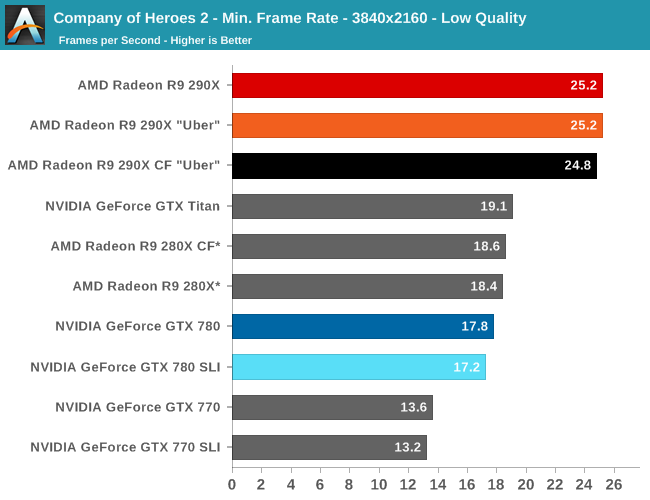
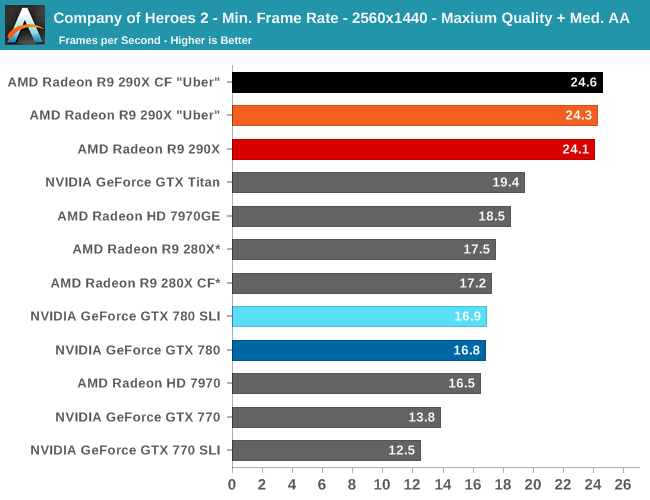

Moving on to minimum framerates, we see that at its most stressful points that nothing, not even 290X, can keep its minimums above 30fps. For a strategy game this is bearable, but we certainly wouldn’t mind more performance. AMD will be pleased though, as their performance advantage over the GTX 780 is only further extended here; a 29% average performance advantage becomes a 43% minimum performance advantage at 2560.
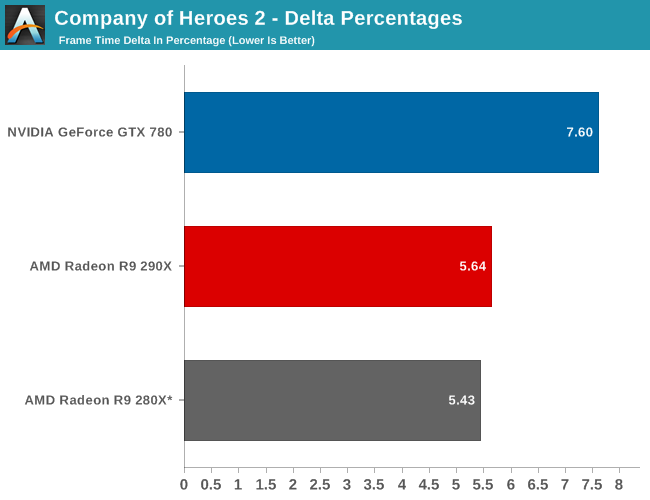
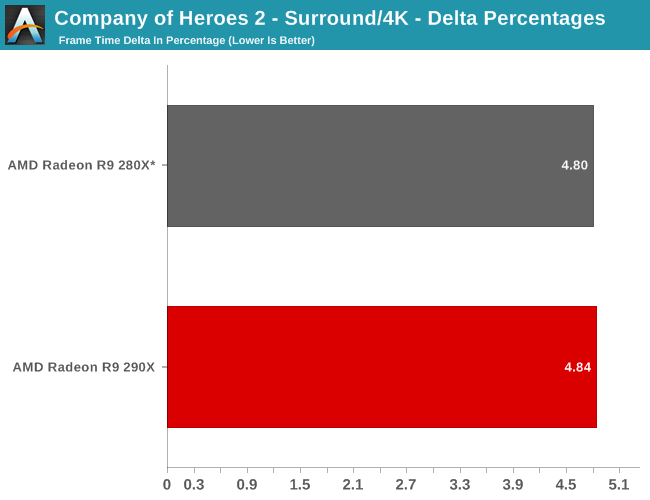
Finally, while we don’t see any performance advantages from AFR on this game we did run our FCAT benchmarks anyhow to quickly capture the delta percentages. Company of Heroes 2 has a higher than average variance even among single cards, which results in deltas being above 5%. The difference between 5% and 7% is not going to be too significant in practice here, but along with AMD’s performance advantage they do have slightly more consistent frame times than the GTX 780. Though in both the case of the 280X and the 290X we’re looking at what are essentially the same deltas, so while the 290X improves on framerates versus the 280X, it doesn’t bring with it any improvements in frame time consistency.










396 Comments
View All Comments
Pontius - Tuesday, October 29, 2013 - link
Some good points Jian, I would like to see side by side comparisons as well. However, I've seen some studies that implement the same algorithm in both OpenCL and CUDA and the results are mostly the same if properly implemented. I've been doing GPU computing development in my spare time over the last year and OpenCL does have one advantage over CUDA that is the reason I use it: run-time compilation. If at run-time you are working with various data sets that involve checking many conditionals, you can compile a kernel with the conditionals stripped out and get a good performance increase since GPUs aren't good at conditionals like CPUs are. But in the end, I agree, more apples to apples comparisons are needed.azixtgo - Thursday, October 24, 2013 - link
the titan is irrelevant. I can't figure why the hell people think a $1000 GPU is even worth mentioning. It's not for sane people to buy and definitely not a genuine effort by nvidia. They saw an opportunity and went for itBloodcalibur - Thursday, October 24, 2013 - link
It's $350 more because of it's compute performance ugh. It benchmarks 5-6x more than the 780 on DGEMM. This is why the card is priced a whopping $350 more than their own 780 which is only a few FPS lower on most games and setups. The only people that should've bought a Titan were people who both GAME and do a little bit of computing.To compare it to the 290x are what retarded ignorant people are doing. Compare it to the 780 which it does beat out. Now we have to wait for nvidia's response.
Cellar Door - Thursday, October 24, 2013 - link
Read the review before trolling. It's $549azixtgo - Thursday, October 24, 2013 - link
technically it's a good value. I think. I despise the higher prices as well but who really knows the value of the product. Comparing a GPU to a lot of things (like a ps4 that has a million other components or a complete PC ), maybe not. but comparing this to nvidia... well...Pounds - Thursday, October 24, 2013 - link
Did the nvidia fanboy get his feelings hurt?superflex - Thursday, October 24, 2013 - link
Yes, and his wallet got shredded.Validation is a bitch.
piroroadkill - Thursday, October 24, 2013 - link
Huh? You can go over to Newegg right now and buy one for $580.Wreckage - Thursday, October 24, 2013 - link
He did not say "Mantle" 7 times so he might not be from their PR department.Either way the 290 is hot, loud, power hungry and nothing new in the performance department. It's cheap but that won't last. Looks like we will have to wait form Maxwell for something truly new.
chrnochime - Thursday, October 24, 2013 - link
You OTOH look like you can't RTFA.